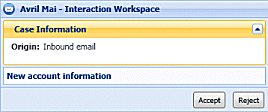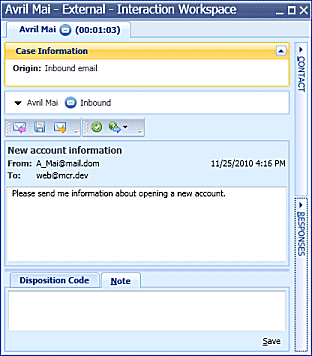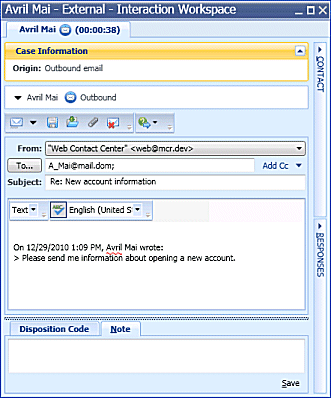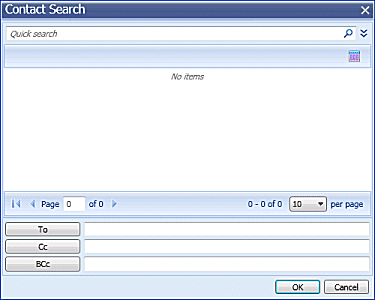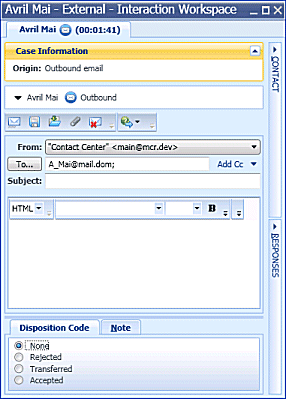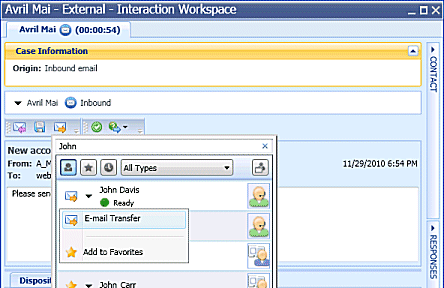Handle An E-Mail Interaction
Contents
- 1 Handle An E-Mail Interaction
- 1.1 Receiving and Handling an Inbound E-Mail Interaction
- 1.2 Creating and Handling a New or Reply E-Mail Interaction
- 1.3 Transferring or Forwarding an E-Mail Interaction
- 1.4 Resending a Previously Sent E-mail Interaction
- 1.5 Spelling Check
- 1.6 Printing and Print Preview
- 1.7 E-Mail Quality Assurance (QA) Review
In this lesson, you will learn how to handle inbound e-mail interactions and launch outbound e-mail interactions. This lesson contains the following sections:
- Receiving and Handling an Inbound E-Mail Interaction
- Creating and Handling a New or Reply E-Mail Interaction
- Transferring or Forwarding an E-Mail Interaction
- Resending a Previously Sent E-mail Interaction
- Spelling Check
- Printing and Print Preview
- E-Mail Quality Assurance (QA) Review
Receiving and Handling an Inbound E-Mail Interaction
If you are the selected internal target for an inbound e-mail interaction, you receive a notice on your workstation desktop. You can decide to accept or reject the interaction. If you accept it, the Interaction window is displayed. The E-Mail Interaction window contains information about the interaction and the controls that you need to complete the interaction.
| Note: You might be configured to have your outbound e-mail interactions sent to your team lead or supervisor for a Quality Assurance (QA) review prior to sending the e-mail interaction to your contact. Refer to E-Mail Quality Assurance (QA) Review. |
Lesson: Handling an inbound e-mail interaction=
- To handle an inbound e-mail interaction properly.
Prerequisites
- You are logged in to Interaction Workspace (see Lesson: Logging in to Interaction Workspace).
- Your status is Ready for the e-mail-media channel (see Lesson: Going Ready in the Interaction Workspace Main window).
- You are the internal target for the inbound interaction.
Start
- A preview of the inbound interaction is displayed on your workstation desktop in an interactive-notification view (see the E-Mail Interaction interactive notification figure). The Interaction Preview contains a summary of information that pertains to the interaction, including contact information and interaction type. The Interaction Preview might also contain Case Information, which is part of the case data about the interaction.
- You can choose to accept or reject the interaction in the Interaction Preview by performing one of the followings steps:
- Click Accept to display the interaction.
- Click Reject to return the interaction to the queue.
- Do nothing. The interaction will time out and be redirected.
- If you accept the interaction, the inbound E-Mail Interaction window is displayed (see the Inbound E-Mail Interaction window figure).
The Inbound E-Mail Interaction window provides the following functionality:
- Reply or Reply All to the sender of the e-mail message and other recipients. See Lesson: Replying to a inbound e-mail interaction.
- Save the e-mail in the In Progress workbin and close the E-Mail Interaction window. See Managing Contact History.
- Transfer the e-mail message to another internal target or forward it to an external resource. See Transferring or Forwarding an E-Mail Interaction.
- Select Mark Done for the current interaction, save the e-mail message in the contact history and close the E-Mail Interaction window; the processing of the corresponding e-mail thread with the contact is complete.
- Consult with an internal target or with a contact. See Starting a Voice Conference or Lesson: Initiating an Instant Messaging session.
- Set a disposition code. See Assigning Disposition Codes.
- Use the Notepad to attach a note to the interaction history. See Managing Contact History.
- View and edit Case Information for the current interaction. Link to a web-page from a hyperlink in the Case Information view. The case information might contain a hyperlink to enable you to view a web-page that is related to the interaction, such as customer records. Click the hyperlink in the Case Information view to open a new browser window and view the link. Place your mouse pointer over the hyperlink to preview the web page from the Case Information view. The hyperlink might be a URL or highlighted anchor text.
- Call the sender by clicking the Action menu that is displayed next to the contact name. See Making a Voice Call
- View and manage contact history. See Managing Contact History
- View and manage contact information. See Lesson: Finding and viewing an interaction in the contact database
- View the Standard Response Library if you decide to call the sender instead of replying to the e-mail. See Inserting a Standard Response into an E-Mail Interaction.
- Print the e-mail message. See Printing and Print Preview.
- If there are interactions in progress for the current contact, the number of interactions is displayed beside the connection status of the interaction (see the Dynamic Contact History Matrix displaying the number and type of interactions in progress figure). Place your mouse pointer over the icon to display the number and type of interaction(s) in progress (except voice interactions) for the current contact.
You might be configured to be notified if there are recent interactions for the current contact; if so, the number of recent interactions is displayed beside the connection status of the interaction (see the Recent interactions matrix displaying the list of interactions with the current contact within the last day figure). Place your mouse pointer over the icon to display the number and type of recent interactions for the current contact. If you click the icon, the Contact view is opened and the History tab is displayed. Your system administrator defines the contents as interactions during the last-specified number of days.
End
Creating and Handling a New or Reply E-Mail Interaction
You can create new e-mail interactions in two ways by replying to an inbound e-mail interaction (see Lesson: Handling an inbound e-mail interaction) and by using the Team Communicator (see Lesson: Using the Team Communicator feature to find a contact) or Contact Directory (see Lesson: Finding and viewing your interactions in the contact database) to find a contact and select the contact as the target of a new outbound e-mail interaction.
Lesson: Replying to a inbound e-mail interaction=
- To send a reply to e-mail interactions that have been directed to you.
Prerequisites
- You are logged in to Interaction Workspace (see Lesson: Logging in to Interaction Workspace).
- You have accepted the inbound or transferred e-mail interaction.
- You have clicked Reply or Reply All in the inbound E-Mail Interaction window (see Lesson: Receiving and Handling an Inbound E-Mail Interaction).
Start
- If you clicked Reply or Reply All in the inbound E-Mail Interaction window, the outbound E-Mail Interaction window is displayed (see the Outbound E-Mail Interaction window, displaying text content type figure).
You might be configured to have signatures inserted automatically into new or reply e-mail interactions based on the sender that you select. The signature will be placed automatically below the text insertion point and above any text that is quoted from the e-mail message to which you are replying. You might be configured to have the contents of the original e-mail included in the body of the reply e-mail.
The outbound E-Mail Interaction window provides the following functionality:
- Send--Sends your response to the sender and other recipients, and saves a copy in the Contact History. The corresponding inbound interaction is marked done automatically.
- Send Interim--Sends your response, closes the outbound E-Mail Interaction window. The inbound e-mail interaction is reopened in the same window. You can create a second reply e-mail message, or you can consult about the reply with another party. If you close the inbound E-Mail Window, you can re-open it from the In-Progress workbin (see Using Workbins to Access Stored Interactions).
- Save--Store what you have written so far.
- Save in Draft Workbin--Store what you have written in the Draft workbin (see Using Workbins to Access Stored Interactions) and close the outbound E-Mail Interaction window.
- Add Attachments--Open an Explorer window and navigate to a file that is to be sent with the outbound e-mail.
- Delete--Discard the outbound reply without saving a copy in the Contact History or the In-Progress workbin. The inbound E-Mail Interaction window is displayed again on your desktop. The interaction is not marked done.
- Consultation (Voice/IM)--Launches a consultation session with another party. Use the Team Communicator to start a voice or IM session with another party (see Starting a Voice Conference or Lesson: Initiating an Instant Messaging session). The consultation interaction is displayed at the bottom of the outbound E-Mail Interaction window.
- Print the e-mail message. See Printing and Print Preview.
- You can edit any of the outbound e-mail parameters before you send the e-mail.
- To change the name of the sender, click the From drop-down menu and select an alternate sender.
- To change the target of the outbound e-mail, click the To button.
The Contact Search dialog box is displayed (see the Contact Search dialog box figure).
- Enter the name, phone number, or e-mail address of a target and then click the magnifying glass.
- Select the target in the results table. For more information about contact search, see Lesson: Finding and viewing your interactions in the contact database.
- Click To, Cc, or Bcc to specify that the target is the primary recipient, a copied recipient, or a blind copied recipient.
- When you have finished adding recipients, click OK. Click Cancel to return to the outbound E-Mail Interaction window without changing the recipient(s).
- You can also add carbon copy (Cc) and blind copy (Bcc) recipients by clicking the Add Cc drop-down menu and selecting Add Cc or Add Bcc respectively.
A new Cc or Bcc field is added in the recipient area. Click in the text field to open the Team Communicator and select a recipient, or click Cc or Bcc to open the Contact Search dialog box (see the Contact Search dialog box figure). You can remove Cc and Bcc fields by clicking the X that is displayed next to the field.
You can edit the To, Cc, and Bcc fields by typing directly into the fields. The Team Communicator is displayed to enable you to select a recipient from the contact database. - You can edit the default subject of the e-mail. By default, the subject of the inbound e-mail is used.
- Enter your text at the insertion point.
- Paste text into the text field from another document.
- Insert a standard response (see Lesson: Using The Standard Response Library).
- Font--Select one of your installed fonts from the Font drop-down list.
- Font size--Select the point size of your text. Available font size depends on the font that is selected.
- Face--Click the Bold, Italic, and Underlined buttons to select and un-select any combination of these faces.
- Color--Click the color box to open the color picker, and select a color.
- Paragraph type--Click the numbered or bulleted button to change paragraphs to a numbered list or a bulleted list, respectively. Click the button again to revert to standard paragraphs.
- Paragraph alignment--Click the paragraph alignment buttons to align paragraphs left, right, centered, or justified.
End
Lesson: Creating and sending a new e-mail interaction to a contact=
- To create a new e-mail interaction and send it to a selected recipient or recipients.
Prerequisites
- You are logged in to Interaction Workspace (see Lesson: Logging in to Interaction Workspace).
- Your role enables you to send new e-mail.
Start
- There are multiple ways to create a new e-mail interaction:
- From the Team Communicator, find a contact (see Lesson: Using the Team Communicator feature to find a contact), and select New E-Mail from the Action menu.
- From an open interaction (voice, e-mail, chat, or workitem), select New E-Mail from the Action menu drop-down list that is displayed next to the contact name (see the New E-Mail option in the Action menu drop-down list that is displayed next to an active contact name figure).
- From the Contact Directory, find a contact, and select New E-Mail from the E-Mail Action menu or from the More Actions menu.
A new E-Mail Interaction window is displayed on your desktop (see the New E-Mail Interaction window figure). The name of the contact is specified in the To field, and your default sender address that is displayed in the From drop-down list.
Note: You might be configured to have signatures inserted automatically into new or reply e-mail interactions based on the sender that you select. The signature will be placed automatically below the text insertion point and above any text that is quoted from the e-mail message to which you are replying. The new E-Mail Interaction window has the same functionality as the reply E-Mail Interaction window (see Lesson: Replying to a inbound e-mail interaction), except that the Notepad tab is not available.
- When you have completed composing, formatting (optional), and checking the spelling (see Lesson: Using Spelling Check to find potentially misspelled words in an outbound e-mail message) of your new e-mail, click the Send button to send the new e-mail to the recipient(s).
End
Transferring or Forwarding an E-Mail Interaction
The Interaction Workspace E-Mail Interaction window enables you to transfer or forward your current e-mail message interaction to another party. In this section, you will learn how to use the Team Communicator feature to transfer an e-mail interaction to an internal target or to a contact or to forward an e-mail to an external resource that is configured in your corporate directory. The Team Communicator enables you to find an internal target or a contact, send an Instant Message (IM) to an internal target, call a contact or an internal target, initiate a conference, or transfer a call. This section contains the following procedures:
Lesson: Initiating an e-mail transfer=
- To find an internal target (such as an agent, Routing Point, or queue) and then transfer the e-mail message to the target.
Prerequisites
- You are logged in to Interaction Workspace (see Lesson: Logging in to Interaction Workspace).
- You have an active interaction with a contact (see Receiving and Handling an Inbound E-Mail Interaction).
Start
- To transfer the e-mail message, in the active E-Mail Interaction window, click Transfer to open the Team Communicator (see the Finding an internal target for an e-mail transfer in the active E-Mail Interaction window figure) to find the internal target to whom you want to transfer the current interaction (see Lesson: Using the Team Communicator feature to find an internal target).
- Click the Action Menu drop-down list that is displayed next to the name of the internal target to whom you want to transfer the interaction, and then select E-Mail Transfer. An invitation is sent to the target to accept the e-mail transfer. If the target accepts the interaction transfer request, the interaction window closes on your desktop and opens on the desktop of the transfer target. If the target does not accept the interaction transfer request, the E-Mail Interaction window remains displayed on your desktop and an error is displayed both at the top of the window (see the Interaction Workspace E-Mail Interaction window displaying a message that the transfer target rejected the transfer request figure) and in the Interaction Workspace My Messages interactive notification.
End
Lesson: Initiating an e-mail forward to an external resource
- To find an external resource, and then forward the e-mail message to the target.
Prerequisites
- You are logged in to Interaction Workspace (see Lesson: Logging in to Interaction Workspace).
- You have an active interaction with a contact (see Receiving and Handling an Inbound E-Mail Interaction).
| Note: Depending on how the Forward to External Resource Business Process is designed by your administrator, the Notes tab might be used to contain instructions to generate the e-mail interaction that is sent to the external resource. |
Start
- To forward the e-mail message to an external resource, click Forward the email to External Resource on the active inbound e-mail window toolbar to open the Team Communicator.
- Enter the valid e-mail address or find a contact to which the e-mail message is to be forwarded.
- Click the Action Menu drop-down list that is displayed next to the name of the external resource to whom you want to forward the interaction, and then select E-Mail Forward to External Resource. The interaction window closes on your desktop and the e-mail message is forwarded to the in-box of the external resource.
End
Resending a Previously Sent E-mail Interaction
You can use the Contact History view (refer to Managing Contact History) to resend a previously sent outbound e-mail to the original contact to follow-up with the contact about the interaction. The status of the outbound interaction must be Done. You can edit the contents of the e-mail interaction before you send it.
Lesson: Resending a previously sent e-mail interaction=
- To resend an e-mail interaction that has been marked Done to the same recipient.
Prerequisites
- You are logged in to Interaction Workspace (see Lesson: Logging in to Interaction Workspace).
- There is an outbound e-mail interaction in the Contact History that has already been sent to the contact and is now marked as Done. The e-mail interaction might be a new outbound e-mail interaction, or it might be a reply e-mail interaction.
Start
- In the Main Window or Gadget, or in the Contact Directory of an active interaction window, open the Contact History (refer to Lesson: Finding and viewing an interaction in the contact database).
- Find the e-mail interaction that you want to resend and select it.
- Click Resend.
The E-mail Interaction window is displayed. The message text of the original outbound e-mail interaction and any attachments are copied to the new interaction. The To, From, and CC fields are copied from the original outbound e-mail interaction. - Add the new message text (your follow-up message) in the e-mail text field. You can add content to the e-mail in three ways:
- Enter your text at the insertion point.
- Paste text into the text field from another document.
- Insert a standard response (see Lesson: Using The Standard Response Library).
Refer to Lesson: Replying to a inbound e-mail interaction and Lesson: Creating and sending a new e-mail interaction to a contact for information about the options that are available in the outbound E-mail Interaction window.
- You can check the spelling of the content of your follow-up message by using the Spelling Check functionality (see Lesson: Using Spelling Check to find potentially misspelled words in an outbound e-mail message).
- When you have completed composing, formatting (optional), and checking the spelling of your e-mail interaction, click the Send button to send the e-mail interaction to the recipient(s).
End
Spelling Check
You might be enabled to use the Spelling Check functionality. The outbound E-Mail Interaction window has automatic spelling-check capabilities that enable you to correct misspelled words or add words to your personal dictionary.
Lesson: Using Spelling Check to find potentially misspelled words in an outbound e-mail message
- To verify the spelling of the content of an outbound e-mail message.
Prerequisites
- You are logged in to Interaction Workspace (see Lesson: Logging in to Interaction Workspace).
- You have an active e-mail interaction (see Receiving and Handling an Inbound E-Mail Interaction or Creating and Handling a New or Reply E-Mail Interaction).
Start
- Begin entering text in the composition area of a new (Lesson: Creating and sending a new e-mail interaction to a contact) or a reply (Lesson: Replying to a inbound e-mail interaction) outbound e-mail message. You can enter text by typing at the insertion point, pasting content from another document, or inserting a standard response (Lesson: Using The Standard Response Library).
- The Spelling Check functionality is controlled by the Spell Check toolbar (you might have to expand the E-Mail Interaction window to see the toolbar).
- Click the Spell Check button to turn Spelling Check functionality on and off.
- From the Language drop-down list, select the spelling dictionary (language) that you want to use.
- When the Spelling Check functionality is on, words in the text composition area that are not in the specified dictionary are underlined by a wavy, red line. The mail composition area displaying a misspelled word that is underlined in red figure shows an e-mail message that contains two words that are not in the English (United States) dictionary. The first is the name of the contact and the second is the word order, which is misspelled as ordder.
- You can correct the spelling by using one of two methods:
- Edit the word(s) manually.
- Right-click the word to display the Spelling Check menu.
- If you right-clicked the misspelled word to display the Spelling Check menu, you can do one of the following:
- Select the correct spelling from the list of suggestion (bold text).
- Ignore--Select to ignore this instance of the word that is not in the specified language dictionary.
- Ignore All--Select to ignore all instances of the word that is not in the specified language dictionary for this interaction only.
- Add to My Dictionary--Select to add the spelling to your personal dictionary (not your corporate dictionary).
- Spell Checking--Select to turn the Spelling Check functionality off or on.
- Languages--Select to open the list of available language dictionaries. You can select a different language dictionary.
End
Printing and Print Preview
You can use the Print Preview window to specify the format of e-mail interactions before you print them.
Lesson: Formatting and printing e-mail interactions
- To preview, format, and print an e-mail interaction.
Start
- From an active E-Mail Interaction window, click Print. The Print Preview window is displayed.
- The Print Preview window contains controls for designing your print layout, and it contains the Print Layout view. You can preview your printout in the Print Layout view. The Print Layout view contains the following controls:
- Zoom in/out--Change the magnification of the view to see more or less detail.
- View at 100%--View the layout at the full printed page size.
- Fit the page into the view by page width--Make the view fit the of the layout fit the width of the window.
- Fit the whole page into the view--Make the entire page fit the window.
- View pages as front and back pairs side-by-side--For two-sided printing, view front and back pages side-by-side.
- From the Destination drop-down list, select a destination printer from the list of available printers on your network.
- Specify which pages to print:
- All--Click All to print the entire e-mail interaction.
- Page Range--Enter one or both of the following in the Page Range text field:
- A range of page numbers, for example: 2-6
- Individual page numbers that are separated by commas., for example: 1,3,4.
- Specify the number of copies to print in the Copies field.
- Specify a Portrait or Landscape layout.
- Specify the page margins:
- Select Uniform Margins to make all the margins match the value that you specify for the top margin.
- To specify different margins for the top, left, right, and bottom margins, de-select Uniform Margins.
Margin units are determined by your local settings.
- Select Add Page Numbers to add page numbers to the printout.
- Print the e-mail interaction by applying the layout that you specify:
- Click Print to print the specified layout.
- Click Cancel to close the Print Preview window.
End
E-Mail Quality Assurance (QA) Review
You might be configured to have your outbound e-mail interactions sent to your team lead or supervisor for a QA review prior to sending the e-mail interaction to your contact (refer to Receiving QA Feedback), or you might be configured to be a QA reviewer (refer to the Lesson: QA Review of E-Mail Interactions).
Receiving QA Feedback
Your QA reviewer might return the e-mail interaction to you to be updated, or the reviewer might accept the e-mail and allow it to be sent. The review process might require more than one iteration. E-mail interactions that are sent for review might be directed to the reviewer or it might be stored in a workbin that is specifically for reviews. The reviewed e-mail interaction might be returned to you directly or it might be stored in a workbin that is specifically for e-mail interactions that are to be updated or reworked. The status of the review is displayed in the Case Information view for the interaction so that you know whether you have to update the e-mail interaction content or not. If the status is Rejected (or some other disposition that is defined by your system administrator), then the e-mail interaction was not sent to the contact. The reviewer might update the content of the e-mail or the reviewer might add instructions for you in the Notepad view. After you have completed the updates to the e-mail interaction, click Send to deliver the e-mail interaction back to the reviewer for approval or rejection. Refer to Receiving and Handling an Inbound E-Mail Interaction, Creating and Handling a New or Reply E-Mail Interaction, and the Interaction Workspace 8.1 Help for information about using the E-Mail Interaction window.
Providing E-Mail QA Feedback
You might be configured to review outbound e-mail interactions created by agents that you supervise, lead, or review, for Quality Assurance (QA) purposes. If you are a reviewer, outbound e-mails are directed to you prior to being sent to a contact. As a reviewer, you might be configured to receive e-mail interactions for review by an interaction preview or you might be configured to retrieve outbound e-mail interactions from a workbin (refer to Lesson: Using Workbins).
Lesson: QA Review of E-Mail Interactions
- To review outbound e-mail interactions from an agent and provide feedback to the agent before sending the e-mail interaction to the recipient.
Prerequisites
- You are logged in to Interaction Workspace (see Lesson: Logging in to Interaction Workspace).
- Your status is Ready for the e-mail-media channel (see Lesson: Going Ready in the Interaction Workspace Main window).
- You are the internal target for the outbound interaction.
Start
- When an e-mail interaction for review is directed to you, an interaction preview is displayed on your desktop.
- Click Accept to display the interaction
- Click Reject to return the interaction to the queue.
The Interaction Preview window displays the Case Information view:- The Origin field specifies the sender of the interaction and indicates that it is for review.
- The QA Review Status field is editable. It contains attached data that specifies the status of the review. When you first receive it, the status might be Unknown or For Review, depending on how your administrator has configured your system. There might be other information about the priority of the interaction or the business area to which it belongs.
- If you accept the e-mail interaction for review, the Review E-mail Interaction window is displayed on your desktop:
- The Case Information view is displayed in the Interaction window.
- The Origin field specifies the sender of the interaction and indicates that it is for review.
- The QA Review Status field is editable. It contains attached data that specifies the status of the review.
- The Party Action menu displays the e-mail monitoring icon to indicate that the agent is under review.
- The Interim Send button is not available for review e-mail interactions.
Review the interaction and provide feedback to the agent who originated the outbound e-mail interaction.
Depending on the policy at your company, you might provide feedback by directly editing the content of the e-mail interaction, or you might add notes for the agent in the Notepad view, or you might discuss the content with the agent verbally. - In the Review E-mail Interaction window, you can do the following tasks:
- Update the Review Status in the Case Information view
- Edit the content of the e-mail interaction
- Set a disposition
- Add text to the Note tab
- Use other standard E-mail Interaction window functions (refer to Receiving and Handling an Inbound E-Mail Interaction)
- When your review is complete, set the status to one of the following states:
- Accepted--The e-mail interaction is sent to the contact when you click Send.
- Rejected--The e-mail interaction is sent back to the agent or to a workbin that contains reviewed interactions when you click Send. The QA Review Status in the Case Information is updated to Rejected.
- Unknown--The e-mail interaction is sent back to the review queue or to a review workbin when you click Send.
- Click Send.
End

